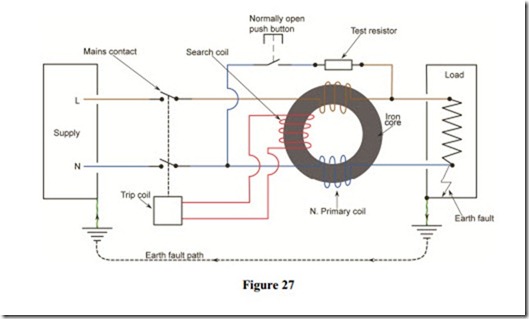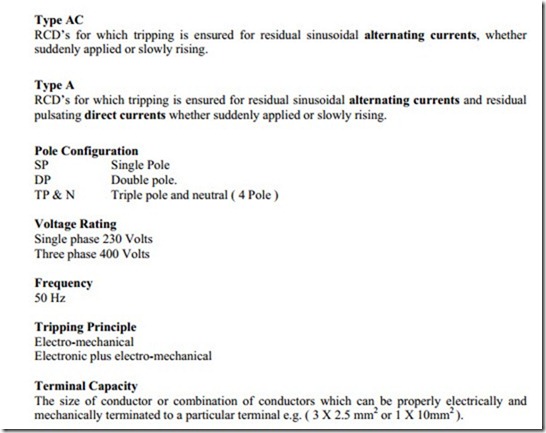Residual Current Devices
Overcurrent protective devices, ( fuses and MCB’s ), are unable to detect earth faults, below their operating currents. Where these are the only means of earth fault protection, it is possible for earth fault currents to flow, undetected, causing shock and / or fire risk. A Residual Current Device ( RCD ) will disconnect earth leakage currents, at or above its tripping current or sensitivity. This greatly reduces the shock and / or fire risk.
Residual current devices should disconnect all live conductors to the protected circuits. There are some exceptions, see ETCI Rules.
Common terms associated with RCD’s
RCCB
Residual Current-operated Circuit Breaker used in distribution boards to protect grouped or individual circuits.
RCBO
Residual Current Breaker with Overcurrent protection. This is a combined RCD / MCB and provides overload, short-circuit and earth fault protection in one unit. Supplies only one circuit.
SRCD
Socket outlet with combined RCD. These are expensive in that they only provide earth fault protection to the load connected to them. They are uneconomic for use in new or re-wire installations, as it is more efficient to protect socket circuits with one main RCD.
PRCD
Portable RCDs are available as a plugtop adaptor i.e. one unit providing a 13 A plugtop at the back end and a 13 A socket on the front. Again, they only provide earth fault protection to the load connected to them.
Current Rating ( Contact Rating )
The current an RCD can carry, make and break, without destruction to itself. e.g. 40 A. Typical Current Ratings are 13 A, 25 A, 40 A, 63 A, 80 A, 100 A. These devices require overcurrent protection, except in the case of the RCBO which has overcurrent protection built in.
Sensitivity ( Tripping Current )
This is commonly called the tripping current and is the value of earth leakage current at which the RCD will trip. The choice of sensitivity depends on the application and must be chosen in compliance with the ETCI Rules. Sensitivities are in the range 10 mA to 500 mA.
Typical Tripping Currents in common use are 30 mA, 100 mA, 300 mA, 500 mA.
Operation of an RCD
An RCD is a device, which operates on the principle of current balance. Both phase and neutral conductors, are wound on a common transformer core forming a pair of primary coils. A secondary coil or search coil, wound on the same core is connected to a trip coil. The trip coil operates the tripping mechanism electro-mechanically. In healthy circuits the current flowing out on the phase conductor, equals the current returning on the neutral conductor. The magnetic effect of these two currents, cancel each other, therefore there is no voltage induced in the search coil.
In the event of an earth leakage fault, current will flow to earth causing an imbalance in the currents flowing through the transformer primary coils. This imbalance causes a magnetic flux to be set up in the transformer core. The magnetic flux in turn induces a voltage in the search coil, which is applied across the trip coil. The trip coil operates, the RCD tripping mechanism and the supply is disconnected from the fault on the circuit or load.
A test button is provided to allow the consumer to periodically test the mechanical operation
of the RCD. It is recommended that the RCD be tested quarterly. Figure 27 illustrates the operation of a residual current device.
Note: Some RCD’s contain electronic components. Where these are installed, precautions must be taken to prevent damage during an Insulation Resistance test
Types of RCD
International Standards IEC 1008 ( RCCB) and IEC 1009 ( RCBO ) divide RCD’s into two performance classes.
Note;
An RCD requires overcurrent protection, otherwise if overloaded its primary coils will burn out.

